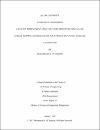CAPACITY IMPROVEMENT AND CYCLE TIME REDUCTION USING VALUE STREAM MAPPING AND SIMULATION FOR A PRODUCTION PLANT IN QATAR, A CASE STUDY
| Advisor | Seth, Dinesh |
| Author | Yameen, Mohammad A.H. |
| Available date | 2017-03-21T08:06:10Z |
| Publication Date | 2017 |
| Abstract | This Project deals with a real life problem of a construction company, and is about capacity mismatches between different manufacturing modules. This mismatch badly influences the production and results in increased cycle time. Thus the objective of this project is to attempt capacity equalization (reducing mismatch) which if taken care off will improve the capacity and will lead to cycle time reduction. The company owns a stabilizing plant. This company operates in Qatar and specialized in infrastructure projects mainly in road construction and road development. This company is anticipating an increase in demand due to booming road construction activities mainly due to 2022 FIFA World Cup and development of infrastructure in line with Qatar National Vision 2030. The company executives were interested for a detailed investigation to analyze the problem of capacity mismatch between the different workstations of their plant and wanted to address the higher cycle time as well. This project was undertaken to investigate the above mentioned problem using scientific and proven process improvement management tools which are in use for such types of problems. For this investigation the student attempted lean based value stream mapping as a major investigation approach. Value stream mapping (VSM) has been in use for the last 20 years to get more from the existing processes without any significant investment. Besides this, it has been in use for capacity improvement and capacity mismatch analysis based situations also. The data were collected from the plant during operation, indicating the cycle time and capacity of each workstation and based on these details current state was prepared. This was an eye opening exercise, and this process management based tool proved as a trigger for improvement and the mismatch related problem was pin pointed. Based on this current state, after exposing various pockets of inefficiency several improvement measures were suggested. Based on these suggested improvements the future state is attempted. As the implementation could not be achieved, so to validate the changes simulation was used as tool to demonstrate the impact of these changes on the cycle time. Simulated future state results after incorporating improvements demonstrated the capacity balance problem and resulted in improvement in cycle time and finally a comparison was made between the two states and future scope of work was reported. |
| Language | en |
| Subject | Capacity equalization Construction project |
| Type | Professional Masters Project |
| Department | Engineering Management |
Files in this item
This item appears in the following Collection(s)
-
Engineering Management [117 items ]


